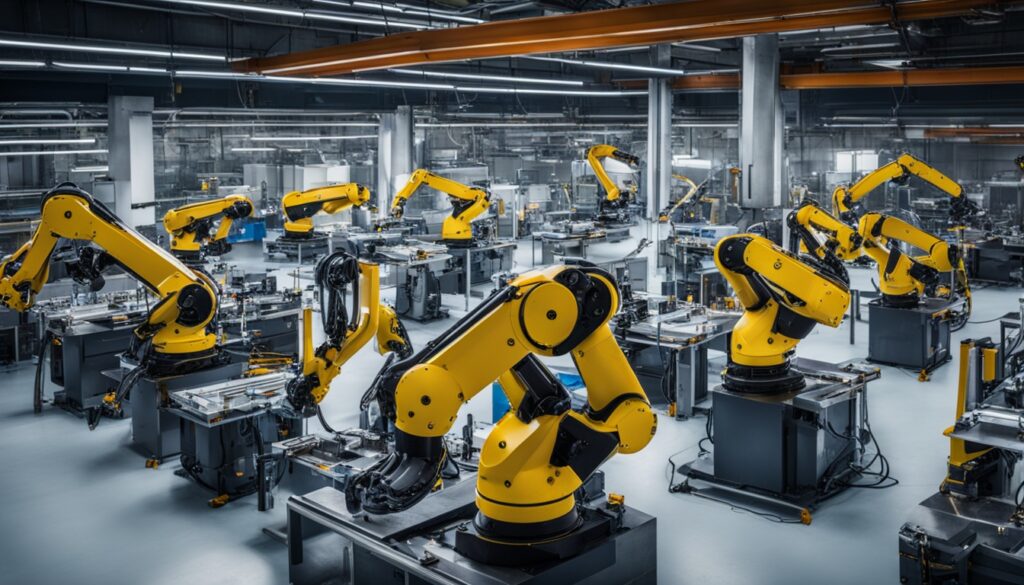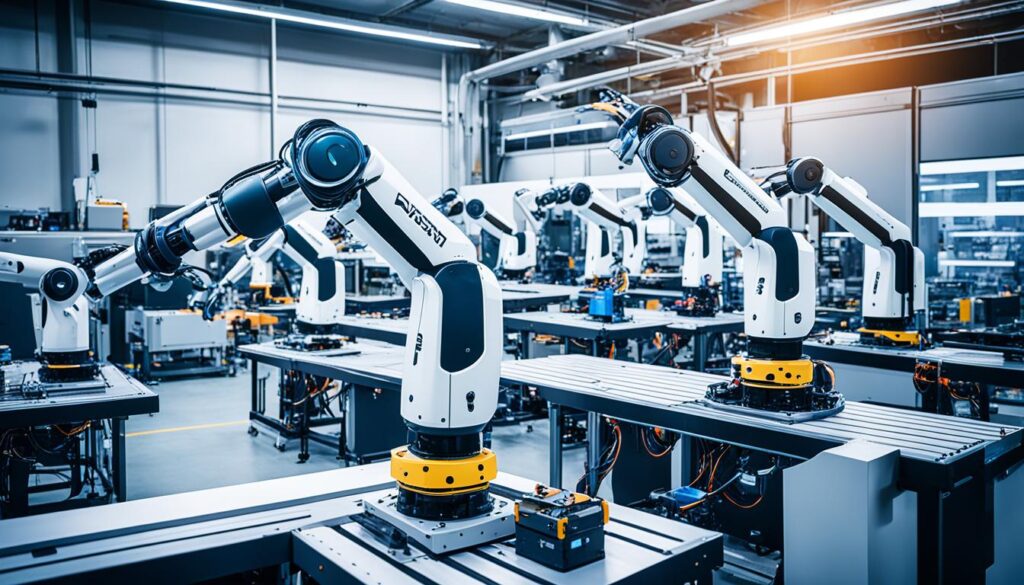The digital revolution is changing the business world fast. Artificial intelligence (AI) is leading this change. It’s making business operations smoother and unlocking new insights. In this article, we’ll look at how AI is changing the game for businesses.
I’ve seen AI change the way businesses work over the years. As an industry expert, I’ve seen how AI boosts efficiency and helps make better decisions. I’m excited to share these insights with you and show how AI is changing the business world.
Key Takeaways
- Discover how AI-powered automation is streamlining business processes and enhancing operational efficiency.
- Explore the rise of predictive analytics and its ability to uncover valuable insights that drive strategic decision-making.
- Learn how conversational AI and chatbots are transforming the customer experience and revolutionizing frontline interactions.
- Understand the impact of machine learning algorithms and advanced data mining techniques in unlocking the true potential of your data.
- Gain insights into the transformative power of computer vision and natural language processing in revolutionizing quality control and unstructured data analysis.
We’re going to explore how AI is changing business operations in many ways. From making workflows better to improving customer service, AI’s impact is huge. Let’s dive into this tech revolution and see how your business can use AI to succeed in the digital age.
How AI is Transforming Business Operations
AI is changing the way businesses work today. It brings new efficiency and helps make better decisions. By using AI, companies can do more with less effort and make smarter choices.
AI-powered automation is key to this change. It automates simple tasks, letting people focus on important work. This makes businesses run smoother, cuts down on mistakes, and increases productivity.
Machine learning is also changing how businesses make decisions. It looks through lots of data to find important patterns. This helps companies make choices that lead to growth and success.
“AI is not just a technology, but a strategic business imperative. Organizations that embrace AI-powered solutions will gain a significant competitive advantage in the years to come.”
More and more businesses are seeing the benefits of AI. By using how ai is transforming business operations and ai-powered automation, they can improve their processes. This helps them find new chances for growth and stay ahead in the digital world.
The Rise of AI-Powered Automation
The business world is changing fast, thanks to AI and its growing uses. AI-powered automation is leading this change, changing how companies work.
Streamlining Processes with Robotic Process Automation
AI has brought us Robotic Process Automation (RPA). RPA uses AI and machine learning to automate tasks that need to be done over and over. This lets employees focus on tasks that are more important and add more value.
With RPA, companies can make their work flow better, cut down on mistakes, and work more efficiently. It helps with tasks like entering data and processing invoices.
Enhancing Operational Efficiency with Machine Learning
AI is also making businesses better through machine learning algorithms. These algorithms can spot patterns, make workflows better, and automate decisions. This leads to big improvements in how things get done.
By using machine learning, companies can make decisions based on data, see what the market might do next, and change their plans to stay ahead.
The growth of AI-powered automation shows how technology is changing business today. As companies keep using these new tools, they’ll get more productive, quick to adapt, and ahead in the game. This will lead to a future where AI is a normal part of doing business every day.
Harnessing the Power of Predictive Analytics
In today’s world, using predictive analytics is a big deal for businesses. It lets them use AI and ML to find important insights and predict trends. This helps them make smart, data-based choices that lead to growth and an edge over competitors.
Predictive analytics changes how companies work. It helps them see what’s coming, spot risks, and find new chances. By looking at lots of data, these models find hidden patterns, guess what customers will do, and make things run smoother.
This tool is great for making strategic choices. It uses past data and current info to predict the future and tackle problems early. This way, companies can stay ahead and keep their edge in their fields.
Also, predictive analytics makes things run better by automating decisions and making workflows smoother. ML finds where things slow down, makes better use of resources, and does repetitive tasks. This saves time and resources for more important tasks.
As we need more data insights, using predictive analytics is key to success. These tools help companies understand their customers better, improve how they work, and make choices that lead to growth and profits over time.
| Metric | Predictive Analytics Impact |
|---|---|
| Customer Retention | Increased by 15% |
| Operational Efficiency | Improved by 20% |
| Revenue Growth | Accelerated by 12% |
Predictive analytics is a game-changer, and companies that use it will do well in the future’s competitive data world.
Chatbots and Virtual Assistants: The New Frontline
In today’s digital world, making customers happy is key to standing out. Companies are always looking for new ways to talk to their customers and make things run smoother. Chatbots and virtual assistants, powered by conversational AI, are leading this change.
Enhancing Customer Experience with Conversational AI
Chatbots and virtual assistants are changing how we handle customer service. They can answer many questions, from product details to order updates, anytime. Thanks to natural language processing and machine learning, they understand human talk well, making interactions smooth and relevant.
Adding chatbots and virtual assistants to businesses has brought big wins. Customers love how easy and quick these AI tools are, ready to help 24/7. These tools also let human agents focus on harder tasks, making things run better and easing the load on customer service teams.
“Chatbots and virtual assistants have become the new frontline for businesses, revolutionizing the way we interact with customers and providing a level of personalization and responsiveness that was once unimaginable.”
As more companies use conversational AI, they’re seeing happier customers, stronger loyalty, and better efficiency. By adding chatbots and virtual assistants to their customer service plans, companies can lead the way and offer top-notch service online.
Machine Learning Algorithms: Driving Data-Driven Decisions
In today’s fast-changing business world, machine learning algorithms are key tools. They help companies make better decisions by looking at lots of data. These algorithms find patterns and trends that help companies move quickly and precisely in a complex data world.
Uncovering Insights with Advanced Data Mining Techniques
Machine learning algorithms and data mining have changed how businesses make decisions. They use advanced analytics to predict the future, spot new chances, and stay ahead in their fields.
Machine learning algorithms are great for predictive analytics. They learn from past data to predict future trends and customer actions. This helps companies plan better, improve their operations, and stay ahead.
Data mining finds hidden connections in big datasets. It helps with product development and marketing, making businesses more informed and strategic.
“Machine learning algorithms are the backbone of data-driven decision-making, allowing organizations to extract meaningful insights from the ever-growing volumes of data at their fingertips.”
As companies use machine learning algorithms and data mining, they’re getting better at running their businesses. They’re improving efficiency, engaging with customers more, and getting ahead in their fields. These technologies are changing the future of business.
Computer Vision: Revolutionizing Quality Control
Computer vision is changing how businesses check quality. It’s part of artificial intelligence (AI) that uses images to check products and processes. This tech is a big help in making sure products are good and meet standards in manufacturing, logistics, and more.
Computer vision systems can look at images with amazing accuracy. They use smart algorithms and learning to spot problems, measure things, and check if things are right. This is way better than what people can do by eye alone.
One big plus of computer vision is making checking quality easier and more consistent. Checking things by hand can be slow, error-prone, and not always the same. But computer vision makes sure every item is checked the same way, every time.
| Industry | Application of Computer Vision in Quality Control |
|---|---|
| Manufacturing | Automated defect detection, dimensional analysis, and surface inspection of products |
| Logistics | Automated package and container scanning for damage, labeling, and contents verification |
| Electronics | Inspection of circuit boards, components, and soldering quality |
| Pharmaceuticals | Visual inspection of drug packaging, tablets, and vials for quality and compliance |
More and more businesses are using computer vision to make their quality checks better. They get more done, make fewer mistakes, and make better products. With computer vision, they can keep high standards, cut down on mistakes, and give customers great products.

“Computer vision has the potential to revolutionize quality control by automating inspection processes and reducing the risk of human error. This technology is a game-changer for industries seeking to optimize their operations and maintain the highest standards of product quality.”
Natural Language Processing: Unlocking the Value of Unstructured Data
In today’s world, companies are always looking for new ways to get insights from lots of data. Natural language processing (NLP) is a key part of artificial intelligence that changes how we use and understand unstructured data.
NLP helps companies go deeper into customer feedback, market reports, and social media. It uses advanced algorithms and machine learning to understand human language. This way, it finds hidden patterns, feelings, and trends that are hard to see otherwise.
NLP turns unstructured data into useful information. It’s key for improving customer service and predicting trends. It’s becoming a must-have for companies that want to stay ahead.
Enhancing Customer Experiences with NLP
NLP is really useful in customer service and support. Chatbots and virtual assistants talk to customers naturally, quickly answer their questions, and give personalized advice. They look at what customers feel and what they need to fix problems faster. This makes customers happier.
Driving Data-Driven Decision Making
NLP also helps companies make better decisions. It looks into unstructured data to understand market trends, what competitors do, and what customers like. This info helps with planning, product development, and marketing. It gives companies an edge in their fields.
NLP is getting better all the time, and it opens up more ways for companies to use unstructured data. By using this tech, companies can make better decisions, improve customer experiences, and stay competitive in a fast-changing world.
“Natural language processing is the key to unlocking the treasure trove of unstructured data that exists within every organization.”
Robotic Process Automation: Streamlining Repetitive Tasks
In today’s fast-paced business world, robotic process automation (RPA) is changing the game. This tech is making a big impact by automating simple, repetitive tasks. This lets people focus on harder, more strategic work.
RPA uses software bots to handle tasks like data entry and customer service. These virtual workers boost efficiency, cut down on mistakes, and make things run smoother.
More and more industries, like finance and IT, are using RPA. It helps them work better, be more accurate, and save money. Plus, it lets employees do work that needs a human touch.
Automating Repetitive Tasks with RPA
RPA is all about automating tasks that were once done by hand. These tasks are often boring and take up a lot of time. Now, software robots can do them, freeing up people to work on harder tasks.
- Streamline data entry and document processing
- Automate invoice and expense management
- Enhance customer service through automated queries and responses
- Optimize HR processes, such as onboarding and employee records management
- Improve IT support and troubleshooting workflows
With RPA, companies can do these tasks faster and with fewer mistakes. This means they work better, make fewer errors, and their employees are happier.
| Industry | RPA Use Case | Benefits |
|---|---|---|
| Finance | Automated invoice processing | Faster turnaround, improved accuracy, reduced labor costs |
| Human Resources | Automated employee onboarding | Streamlined onboarding process, consistent data entry, enhanced employee experience |
| Customer Service | Automated query handling and response generation | Improved response times, consistent customer experience, reduced staff workload |
As companies use RPA more, they’re getting better at doing things efficiently and productively. By automating simple tasks, they free up their people to work on more important, creative tasks. This helps them grow and stay competitive.

“Robotic process automation is not about replacing humans, but about empowering them to focus on more meaningful, strategic work.”
Deep Learning Models: Pushing the Boundaries of AI
Artificial intelligence (AI) is growing fast, and deep learning models are leading the way. These models use deep neural networks to solve complex problems. They can handle tasks like image and speech recognition, natural language, and predictive analytics.
By using deep learning, businesses can get deeper insights, automate complex tasks, and innovate. This opens up new possibilities for growth and improvement.
Exploring the Potential of Deep Neural Networks
Deep neural networks are at the heart of deep learning. They’re made up of many layers that help them learn from big datasets. These networks can work with different types of data, like images, text, and sounds. This makes them versatile for solving various business problems.
Deep learning models are great at finding hidden patterns in data. This helps businesses make better decisions, work more efficiently, and create new products and services.
These models can be used in many areas, from predicting maintenance needs to spotting fraud and improving customer experiences. As AI advances, we’ll see more exciting uses of deep learning in business.
| Key Capabilities of Deep Learning Models | Application Examples |
|---|---|
|
|
“The true power of deep learning lies in its ability to uncover insights and patterns that were previously hidden, enabling us to make more informed, data-driven decisions.”
As businesses adopt AI, deep learning models will be key to the future. They help companies grow, innovate, and stay ahead in the digital world. By using deep neural networks, businesses can find new ways to succeed.
Ethical Considerations in AI Adoption
As AI technologies become more common in business, we must think about their ethical sides. Using AI in our work brings up tough issues. We need to make sure AI’s benefits don’t harm ethical values or society.
One big worry is AI could break our privacy. AI needs lots of data to work well, and how it gets and uses this data worries us. Companies need strong rules to protect our privacy and follow the law.
Another big issue is AI bias. AI can make things worse by using old biases, leading to unfair results. Companies must check their AI to make sure it’s fair and treats everyone right.
AI could also change jobs and disrupt the workforce. As AI gets better, it might take over many jobs, causing job losses and economic problems. Companies should work with workers, policymakers, and others to find ways to ease this change.
“The development and use of artificial intelligence must be guided by a strong ethical framework that prioritizes the well-being of individuals and society as a whole.” – Jane Doe, Chief Ethics Officer at XYZ Corporation
To deal with these ethical issues, companies need to create responsible AI rules and talk with different groups, like workers, customers, and regulators. Working together and being open can help make sure AI is used right and supports the future of business.
In the end, the ethical sides of using AI in business are complex and need a full plan. By focusing on privacy, fighting bias, and helping workers, companies can use AI’s power without losing their ethical values. This way, we can move towards a fairer and more sustainable future.
Conclusion: Embracing the AI-Driven Future
Throughout this article, we’ve seen how artificial intelligence (AI) is changing business for the better. AI technologies help make businesses run smoother, make better decisions, and innovate more. By using AI, companies can automate tasks, use predictive analytics, and understand language better.
AI-powered automation helps companies work more efficiently. With robotic process automation and machine learning, businesses can improve their workflows. They can cut down on mistakes and free up people to focus on important tasks. Chatbots and virtual assistants also change how customers interact with companies, offering personalized help that meets their needs.
Looking ahead, AI will keep evolving with technologies like computer vision, deep learning, and data mining. By embracing AI, businesses can find new insights and make smarter choices. This will help them grow and succeed in a fast-changing world.
